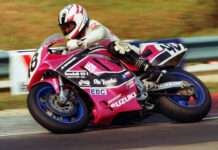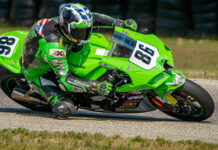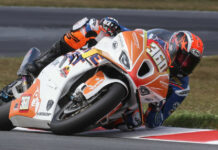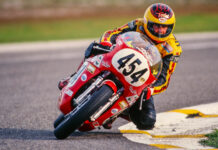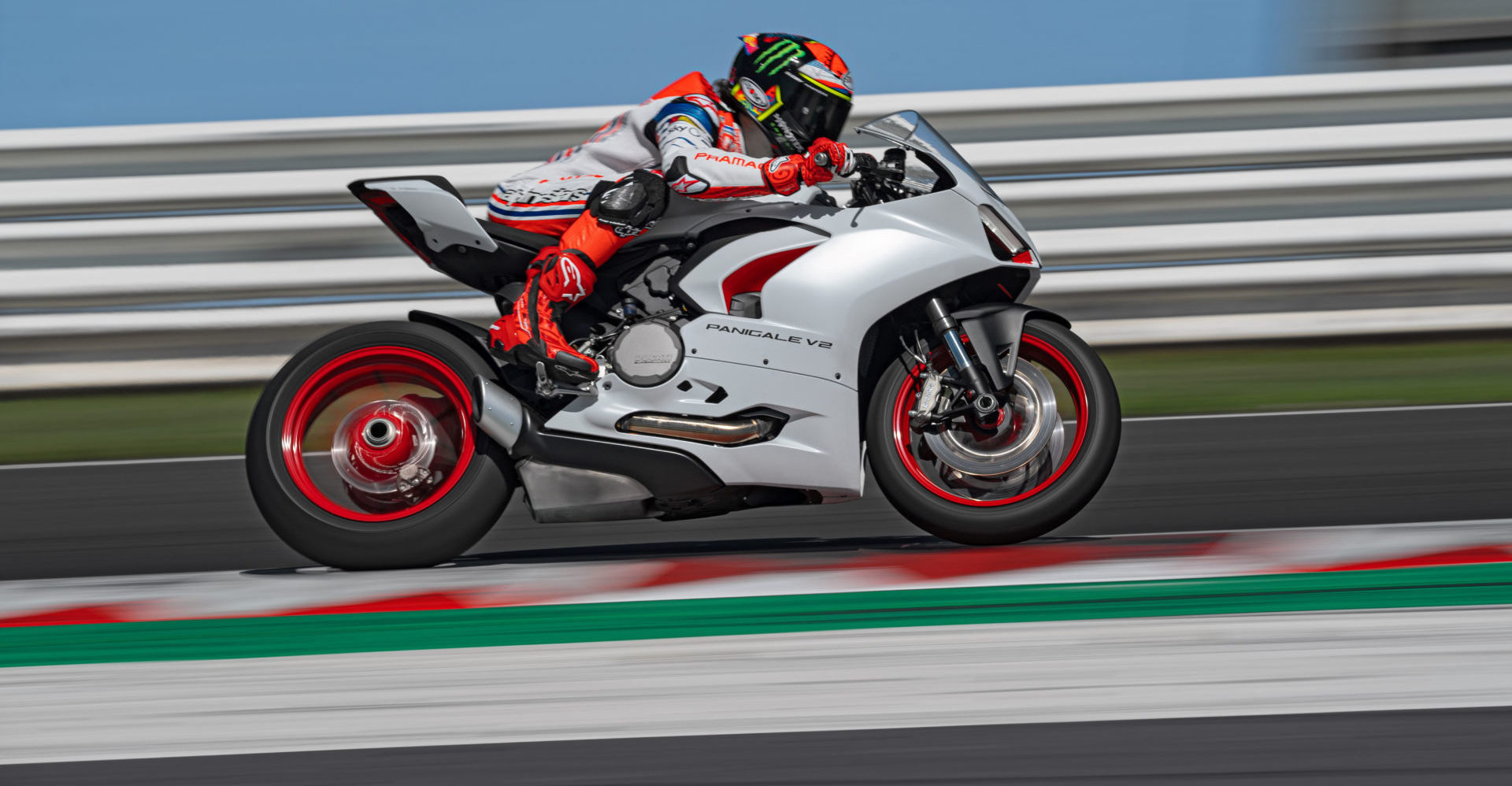Editorial Note: Scroll down to see the update.
COPYRIGHT 2021, ROADRACING WORLD PUBLISHING, INC.
By David Swarts
The recent release of MotoAmerica’s new 2022 technical rules package has resulted in a lot of opinions being expressed, from fans and participants, on social media and a lot of questions being raised.
The most hotly debated and questioned topic is MotoAmerica homologating the Ducati Panigale V2 (955cc V-Twin), MV Agusta F3 (798cc triple), and Triumph Street Triple 765 (765cc triple) to race in the class against 599cc and 636cc inline four-cylinder Supersport machines, which will be allowed to have more engine modifications to help even things out.
To learn more about the situation, Roadracingworld.com posed some questions to MotoAmerica Technical Director Tige Daane and MotoAmerica COO Chuck Aksland in a telephone interview.
Roadracingworld.com (RW): Why is MotoAmerica changing the Supersport rules for 2022?
Tige Daane (TD): “When you’re looking at the future of racing and you’re looking at what’s going on, what kind of bikes manufacturers are selling, what bikes manufacturers want to present, it was really getting behind the manufacturers saying, ‘Hey, we want to help you present these bikes in a racing fashion.’
“So, with the 600s not selling like they were — a lot of manufacturers are pulling out of 600s completely — it was a way to continue on with the Supersport class and allow people to come up through the ranks without having to go from Junior Cup to Stock 1000s or something like that and create a class that you can get a lot of different participation in. So, I think it’s exciting.”
Fact Check: While manufacturers may not be currently selling some 599cc/636cc supersport streetbike models in all markets worldwide due to tightening emissions requirements, Honda, Kawasaki, and Suzuki still sell 599cc and/or 636cc supersport streetbikes in America, and Yamaha still sells the YZF-R6 specifically for people to ride on racetracks.
RW: We understand that FIM came up with this new concept and rules for Supersport, but is there some obligation between MotoAmerica and FIM that MotoAmerica has to follow FIM technical rules?
Chuck Aksland (CA): “No, there’s not. But our goal is to follow the lead of the FIM and align ourselves with them as much as possible. That’s part of our initiative so we can create a series that allows riders to rise through our ranks and hopefully advance to the World Championships.”
RW: From reading the provisional 2022 MotoAmerica Supersport technical rules, we understand that there will be rev limits and performance balancing methods put in place to level the performance of the bikes being allowed in Supersport, but what kind of work is being done to ensure the bikes are as equal as possible starting with the first race?
TD: “[We’re] working together with FIM. They are utilizing the [Yamaha] R6 and other platforms that are being raced at the World Championship level and other National series and they are confiscating [race] engines, and those are being run on a dyno and to gather information to base the [initial] balancing on those numbers from bikes that are already being raced.
RW: And are they doing this type of baseline work with the newly homologated motorcycles as well?
TD: “Absolutely. You obviously start in stock form and then see what you need to do. Because if you think about it, there’s some bikes, even Next Generation bikes, that will need to make more power. There’s some bikes that will obviously need to make less power. We’re trying to get them all in the middle and get them equal so it makes for great racing.”
RW: Has MotoAmerica provided engine data from the bikes that are raced here?
TD: “They [FIM] have our data, and they are getting their own engines prepared exactly like they are here to do their own testing at the same facility. They want all of the testing done at the exact same place, at the same facility.”
RW: Using the 2022 MotoAmerica Supersport rules, what is the anticipated performance gain in a typical 599cc or 636cc inline four-cylinder engine compared with a 2021-spec engine?
TD: “I think you could see gains of three to seven horsepower, somewhere in that range. We’re not really trying to come up with a standard number. Everybody’s dyno is different. We’re not looking for a massive increase in horsepower, let’s put it that way. But we are looking to bring our performance up a notch.”
RW: Where is that performance gained in the engine’s rev range?
TD: “It’s hard to say. Every bike is different.”
RW: In hardware costs alone and not counting the time to develop ignition and fuel maps on the dyno, how much extra will a 2022 MotoAmerica Supersport engine cost to build as opposed to a 2021-spec engine?
TD: “If you look at the rules package, the camshafts have a price cap. [€1,000 per cam for inline engines and €650 per cam for V-Twin engines] If you go by the price cap on the camshafts you can go by the max numbers [$2,314 for inline engines and $3,008 for V-Twins]. Velocity stacks are pretty minimal. Sometimes they can be a couple of hundred bucks and sometimes they can be around $1,000, but usually they are pretty reasonably priced parts.
“It’s definitely going to be increased costs, but I don’t foresee it being a massive, unobtainable cost. That’s why we stayed away from the heads.
“Some people [with 599cc and 636cc inline four-cylinder engines] think they are going to be allowed ported heads. The same rules apply that have applied for the last many years. There’s no change in the head rules except for we’ve allowed blending of the valve seat. Where the valve seat is, a lot of the [engine builders] will take a tool and cut in a little bit right there. So, we’ve allowed 10mm [for the blending]. So, it’s a very small area for you to just blend the valve seat into the port. It’s a very inexpensive [modification]. You can do it by hand. You can do it in your garage. It’s not a required thing. It’s just an allowance we allowed because it’s very inexpensive. I’ve talked to multiple engine builders, and they told me the price to do that would be between $200-$400. That’s the only change that’s been done to the [rules regarding the] cylinder head.”
RW: If these new Supersport rules are a good idea, why does MotoAmerica feel it’s so important to get the word out that teams and riders can still compete with 2021-spec engines and bikes?
CA: “Because we want teams and riders to know that they can continue to race with us without making any changes. We’re not forcing anyone to make these modifications. And in the past, I’ve seen riders win races and Championships on bikes that were down a few horsepower to their competitors’ bikes.”
RW: Does MotoAmerica expect Ducati, MV Agusta, and Triumph to support the new Supersport class with team sponsorships, rider sponsorships, and/or contingency awards?
CA: “That’s up to the manufacturers, but the possibility is there and I think all of them want to sell product and have shown that they want to be involved in the series. What that leads to that’s up to them.”
RW: Have you had any indications from them [Ducati, MV Agusta, and Triumph] that they are going to get involved in MotoAmerica Supersport?
CA: “We have had no discussions with MV, but Ducati and Triumph have been very positive.”
RW: Why are aftermarket wheels now going to be allowed in Stock 1000?
TD: “During the [2021] season I talked to a lot of team owners, and I talked to some of the manufacturers, and right now the biggest issue is wheel supply is really hard for the manufacturers. It’s low. They don’t have a lot of inventory. It’s also very expensive [for riders and teams].
“So, the thought was to allow aftermarket wheels because in a sense they are less expensive at this point. And we’re talking retail pricing and not if you get a deal because you are a supported team. But at retail pricing, actually a lot of the [OE] wheels now are more expensive than OEMs and they’re a little bit more available. That was the reason behind it, trying to give them a little more ease of access and a little less cost.”
RW: Are aftermarket wheels cheaper than all of the OEM wheels from all of the manufacturers currently competing in Stock 1000?
TD: “Pretty much, yeah. There may be a few that are less expensive, but most of them, like the Yamaha, the Kawasaki, the BMW, the Honda, definitely, the [aftermarket] wheels are cheaper.”
CA: “And there is a price cap, too.”
TD: “Yes, there is. There is a price cap. We’re not allowing any aftermarket wheel. There will be an eligibility list and they need to fit under a retail price cap so we can make sure the costs stay lower. That’s the whole point of it.”
RW: Back to balancing in Supersport. You said MotoAmerica will be able to balance things in its Supersport class independently of the FIM Supersport World Championship, correct?
TD: “Yes, if we have to. Correct.”
RW: And all of the domestic National Championships, are they all going to be linked together where they all have to do the same balancing at the same time? In other words, can MotoAmerica balance things based on the results they see in MotoAmerica?
TD: “Every racing series reserves the right to balance things as they see fit for their needs, but the goal is working with everyone to try to get the same balancing levels so it’s pretty universal. That’s the goal. So anytime we would make a change we would definitely be communicating that change.”
RW: Will all of the 599cc and 636cc inline four-cylinder machines be treated as one? Or if one of the current inline four-cylinder bikes blossoms more than the others under the new tuning allowances and starts outperforming the others, will that particular make and model be balanced against the others to even things out?
TD: “You mean like how we currently put [more] weight on the Kawasaki 636 [compared] to the year before? Yes, that can always happen. Correct. If we saw one brand that was just dominating over the Next Generation bikes or over the standard bikes or whatever, the whole class, like what’s been shown in the class any bike can be balanced. The only difference is those [current inline four-cylinder] bikes will not be on a spec ECU, so it won’t be done with an ECU balance. It will be done another way, like what we’ve done in the past [changes to minimum weigh limits].”
RW: Will FIM World Championship officials will be at the Daytona 200?
TD: “Yeah, the FIM guys and the ECU guys. We’re going to bring all of the people to help us and look at all of the data as well.”
RW: But as the season goes along you won’t need the FIM guys to do balancing? You’ll be able to do it, right?
TD: “Correct.”
RW: The 2022 rules say the primary method of balancing will be via torque-limiting maps. Correct?
TD: “Definitely power output is going to be controlled. You have a lot of different ways you can do it. You can do it based on torque. You can do it based on throttle position. You can do it based on engine RPM. So, the algorithm kind of utilizes everything, the inertia of the wheels, the inertia of the crank, everything.”
RW: Is there anything else you want people to know about the new 2022 technical rules?
TD: “If participants have questions about engine parts and rules I’m available. They can always email me [[email protected]] or get ahold of me. I want to make myself available to people to address any questions or concerns they might have.”
UPDATE:
The following portions of the original interview were omitted to reduce the length of the article. We are adding them here because they address more ongoing questions regarding the 2022 MotoAmerica Supersport technical rules.
RW: Where did MotoAmerica get its technical rules for the Daytona 200, especially the rules regarding quick-change setups and refueling hardware?
TD: “I laid out a bunch of rulebooks. I looked at old AMA rulebooks. I looked at FIM rulebooks. I looked at current Daytona [200] rulebooks. And we came up with a gameplan, because with the Daytona 200 we wanted the people who are racing it to be able to race as they’ve already prepared their bikes. So, I kept a lot of the rules the same, and then most of the other rules are just so it’s more defined in a professional level what’s truly allowed and that it’s not completely wide open.”
RW: One that jumped out at me was a rule for the quick-fills. It says “A protective and lockable cover must be affixed on the quick-fill fuel valve(s) if no locking device is already applied to the closing system within the receptive part of the quick-fill fuel valve installed in the motorcycle fuel tank.” So having a locking cover over the quick-fill receptacle seems counter-active to having a quick-fill system. I’ve never really heard that language before. Maybe I’m just not up to speed or something?
TD: “I don’t have that in front of me right this second. We need to make sure there’s a functioning locking piece. So, if you have the quick-fill dump where you can just push it down it needs to be able to push itself back up in place and lock, like it’s been done.
“It’s a much more detailed way to say it needs to be able to seal, it needs to be able to close, it needs to be able to shut, but it doesn’t obviously need to have a locking cap like with a key.
“If you want to use like a Vortex-style cap, a screw-on cap, you can. If you want to use a quick-fill cap, you can. But they must be able to close on their own, just like it’s always been.”
RW: I know it’s a “sporting regulation,” but have you guys considered a pit lane speed limit for the Daytona 200 yet and how you’re going to handle that?
CA: “Yeah, we’re looking at putting a pit lane speed limit in, and we’re working on the other sporting rules. So hopefully, that will be put out shortly. It will be exactly what we do now at other MotoAmerica events.”
CA: “Did you have a question about the…are you squared up on the combined bike-and-rider weight and all that?”
RW: Yeah, I am. The way I understand it is the bike has to weigh no less than 161 kg (354.2 pounds) at any time it comes off the track. And then there’s the combined bike-and-rider [rider in all of their riding gear] minimum weight limit (532.4 pounds/242 kg). But if the bike exceeds the Soft Maximum Weight Limit (378.4 pounds/172 kg) you do not have to meet the combined bike-and-rider minimum weight. Correct?
TD: “That’s exactly correct.”
RW: So, the worst-case scenario is if someone has a bike that is at the minimum weight limit and they have a very light rider, they will have to carry 11 kg (24.2 pounds) of ballast, right?
TD: “When I calculated it the other day it’s somewhere right around there. It’s not like people were thinking they would have to put 50 pounds on it. That’s not the case. The whole goal is to keep the balancing and the weight so one [motorcycle] doesn’t have an advantage over the other. The same way we’ve been doing it in Junior Cup.”


